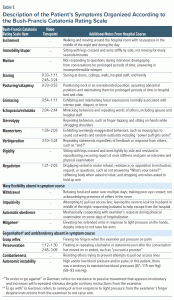Catatonia is a complex, life-threatening neuropsychiatric syndrome presenting with a constellation of behaviors, motor symptoms, and autonomic dysregulation.1–3 While it may signify a primary psychiatric etiology, catatonic presentations often develop secondary to substance exposure or medical illnesses. Catatonia has been noted as part of the symptom complex of autoimmune encephalitis, which with early detection can be treatable to full recovery.4,5 Catatonia is challenging to diagnose due to a wide range of associated symptoms.6,7 In an effort to facilitate prompt recognition and treatment, a now-recovered patient requests the dissemination of video taken by her spouse documenting her catatonia, ultimately determined to be secondary to anti-N-methyl-d-aspartate receptor (NMDAr) encephalitis.
Case Report
A 47-year-old woman with a history of 2 psychiatric admissions for suicidal ideation 10 years prior presented with altered mental status 1 week after treatment with high-dose corticosteroids for a new diagnosis of optic neuritis. She exhibited waxing and waning lucidity, paranoia, visual hallucinations, crying, laughing, staring, grimacing, echolalia/echopraxia, mannerisms, verbigeration, and negativism (Video, Table 1). She also exhibited motor symptoms of rigidity and autonomic dysregulation with hypotension. Symptoms did not remit with steroid discontinuation. Electroencephalogram revealed no epileptic activity. Brain magnetic resonance imaging demonstrated leptomeningeal enhancement in the left orbitofrontal cortex and frontoparietal lobe, raising concern for encephalitis. Serum and cerebrospinal fluid autoimmune panel returned positive for anti-NMDAr antibodies. She was treated with plasma exchange therapy, which commenced while awaiting autoimmune panel results, and rituximab. For symptomatic treatment of catatonia, lorazepam, valproic acid, and aripiprazole were administered. Obstetrics-gynecology follow-up ruled out the presence of an ovarian tumor. Over the course of the subsequent year, she completely recovered to her previous baseline mental and functional status, and psychotropic agents were tapered to discontinuation.
© Copyright 2023. The patient retains copyright.

Discussion
Catatonia describes a complex neuropsychiatric syndrome with characteristic behavioral and motor symptoms. The patient presented with classic symptoms of catatonia due to anti-NMDAr encephalitis. The history of previous psychiatric admissions may have delayed recognition of the underlying cause of the patient’s neuropsychiatric symptoms. Fortunately, neurologic abnormalities, including visual changes and weakness, were recognized and further evaluated with electroencephalogram (to assess for seizure activity), lumbar puncture (to assess for viral encephalitis and autoimmune or paraneoplastic antibodies), and brain magnetic resonance imaging (to exclude intracranial contributors to altered mental status), leading to timely diagnosis and treatment.
Upwards of 50% of catatonia cases are related to an underlying medical cause, including ovarian teratomas with associated anti-NMDAr encephalitis.8 Therefore, psychiatrists should maintain broad differential diagnoses and a low threshold to assess vital signs and perform neurologic examinations. Diagnosis and treatment of anti-NDMAr encephalitis are described elsewhere.9,10 The characteristic behavior and motor symptoms of catatonia are assessed and monitored using the Bush-Francis Catatonia Rating Scale (BFCRS).11 To promote early recognition, assessment, and treatment of catatonia, we offer documentation (Video) and descriptions of symptoms (Table 1) displayed by our patient organized according to the BFCRS.
Article Information
Published Online: September 26, 2023. https://doi.org/10.4088/PCC.22cr03460
© 2023 Physicians Postgraduate Press, Inc.
Prim Care Companion CNS Disord 2023;25(5):22cr03460
Submitted: December 4, 2022; accepted March 24, 2023.
To Cite: Dalapati T, Robbins-Welty G, Wolthusen RPF, et al. A multimedia description of catatonia secondary to anti-NMDA-receptor encephalitis. Prim Care Companion CNS Disord. 2023;25(5):22cr03460.
Author Affiliations: School of Medicine, Duke University, Durham, North Carolina (Dalapati); Department of Psychiatry and Behavioral Sciences, Duke University, Durham, North Carolina (Robbins-Welty, Wolthusen, Staplefoote-Boynton, Diocares, Gagliardi); Department of Neurology, Duke University, Durham, North Carolina (Skeen).
Corresponding Author: Jane P. Gagliardi, MD, MHS, 2301 Erwin Road Durham, NC 27710 ([email protected]).
Relevant Financial Relationships: Dr Wolthusen is Director of the German Mental Health N.G.O. “On the Move e.V.” Dr Skeen reports consulting relationships with Novartis, Biogen, Bristol Myers Squib, Alexion, EMD Serono, and WCG. Dr Gagliardi receives support for CME activities associated with her role as associate director of the Train New Trainers Primary Care Psychiatry Fellowship. Drs Robbins-Welty, Staplefoote-Boynton, and Diocares and Ms Dalapati report no relationships with commercial interests.
Funding/Support: None.
Patient Consent: Written consent was received from the patient to publish the case report and video. Information has been de-identified to protect anonymity.
ORCID: Trisha Dalapati: https://orcid.org/0000-0001-6319-5253
References (11)

- Kaestner F, Mostert C, Behnken A, et al. Therapeutic strategies for catatonia in paraneoplastic encephalitis. World J Biol Psychiatry. 2008;9(3):236–240. PubMed CrossRef
- Ferrafiat V, Raffin M, Freri E, et al. A causality algorithm to guide diagnosis and treatment of catatonia due to autoimmune conditions in children and adolescents. Schizophr Res. 2018;200:68–76. PubMed CrossRef
- Fink M. Catatonia from its creation to DSM-V: Considerations for ICD. Indian J Psychiatry. 2011;53(3):214–217. PubMed CrossRef
- Daniels J. Catatonia: clinical aspects and neurobiological correlates. J Neuropsychiatry Clin Neurosci. 2009;21(4):371–380. PubMed CrossRef
- Marques Macedo I, Gama Marques J. Catatonia secondary to anti-N-methyl-D-aspartate receptor (NMDAr) encephalitis: a review. CNS Spectr. 2020;25(4):475–492. PubMed CrossRef
- Lee A, Glick DB, Dinwiddie SH. Electroconvulsive therapy in a pediatric patient with malignant catatonia and paraneoplastic limbic encephalitis. J ECT. 2006;22(4):267–270. PubMed CrossRef
- van der Heijden FM, Tuinier S, Arts NJ, et al. Catatonia: disappeared or under-diagnosed? Psychopathology. 2005;38(1):3–8. PubMed CrossRef
- Dalmau J, Tüzün E, Wu HY, et al. Paraneoplastic anti-N-methyl-D-aspartate receptor encephalitis associated with ovarian teratoma. Ann Neurol. 2007;61(1):25–36. PubMed CrossRef
- Dalmau J, Armangué T, Planagumà J, et al. An update on anti-NMDA receptor encephalitis for neurologists and psychiatrists: mechanisms and models. Lancet Neurol. 2019;18(11):1045–1057. PubMed CrossRef
- Titulaer MJ, McCracken L, Gabilondo I, et al. Treatment and prognostic factors for long-term outcome in patients with anti-NMDA receptor encephalitis: an observational cohort study. Lancet Neurol. 2013;12(2):157–165. PubMed CrossRef
- Bush G, Fink M, Petrides G, et al. Catatonia, I: rating scale and standardized examination. Acta Psychiatr Scand. 1996;93(2):129–136. PubMed CrossRef
Enjoy free PDF downloads as part of your membership!
Save
Cite
Advertisement
GAM ID: sidebar-top




